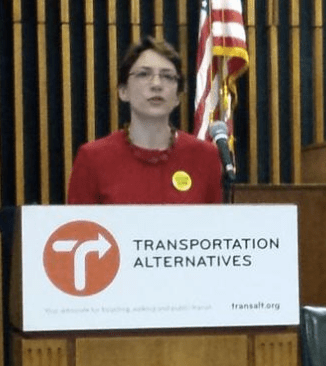Street safety professionals, elected officials, and advocates from cities around the world gathered in New York today for the Vision Zero for Cities Symposium, a conference organized by Transportation Alternatives to examine New York's street safety approach and share best practices for eliminating traffic fatalities.

The morning panels featured Transportation Commissioner Polly Trottenberg, TLC Commissioner Meera Joshi, elected officials, and members of Families for Safe Streets, among others. Lots of items came up for discussion, including some small announcements from city officials. Here are the highlights:
- Big changes for Queens Boulevard: Queens Boulevard will have its speed limit lowered to 25 mph by the end of the year, Trottenberg announced. (Although DOT said in May that the "Boulevard of Death" would become an arterial Slow Zone, the agency previously said it would maintain the street's existing 30 mph limit.) Trottenberg also confirmed that DOT will soon host meetings to kick off a comprehensive redesign of Queens Boulevard.
- Speed cams work, but rollout is slow: Trottenberg said speeding has dropped anywhere from 11 to 46 percent where speed cameras have been installed. Today, there are 29 speed cams in NYC. DOT aims to have 46 cameras on the streets by the end of this year, with the full complement of 140 by the end of next year. Trottenberg said the city's cumbersome procurement process caused much of the early delay, but the city is taking its time to ensure that cameras are calibrated and operating properly, to avoid incorrectly-issued tickets that can undermine support for the program. The de Blasio administration ultimately seeks home rule over automated enforcement. I asked if the slow rollout meant that asking for more speed cameras would not be on the city's agenda in Albany next year. "We will be going back at some point, but I don't know when," Trottenberg said. "The thing that's probably most at play is that we do it right."
- Fewer bad drivers are slipping through the cracks at TLC: For three years, TLC let 4,500 dangerous drivers stay on the road because it incorrectly tabulated data from the Department of Motor Vehicles as part of its "Critical Driver Program." The program revokes or suspends hack licenses of cabbies who have accumulated points on their drivers licenses. Since fixing the error in September 2013, Joshi said TLC has increased the number of suspensions or revocations four-fold, to 3,000 so far this year.
- Keeping tabs on dangerous driving: The city is already expanding the use of CANceivers, which can record months of driving data, to its entire fleet. The aim is to improve the safety of city drivers. "If that person is speeding, their boss is gonna know," Trottenberg said. Joshi said today that TLC's fleet, such as its enforcement vehicles, has had the new tech for the past few months. TLC hopes to approve pilots for black box technology in some taxis soon [PDF], which would collect less information than CANceivers but more than the limited black boxes found in virtually all new cars.
- Getting the message out: TLC's Joshi and NYPD Chief of Transportation Thomas Chan said their agencies will both soon release their own Vision Zero videos. TLC's will feature families of traffic violence victims and will be shown to all taxi and livery drivers. Chan also touted the NYPD's partnership with traffic mobile app Waze, which recently sent a message to its users alerting them to the city's new 25 mph speed limit. (The problem? Waze told its users that traveling at 25 mph "is likely to create delays, traffic build-ups and other hazards for drivers in the area" and that they should "plan ahead and navigate around the major traffic areas in the city.")
- More traffic injury data now public: NYPD and DOT weren't the only agencies with news about traffic safety data this morning. Department of Health Assistant Commissioner Nancy Clark announced that her agency now posts data on emergency room visits and hospitalizations for bicyclists and pedestrians to its website.
What's next for Vision Zero? City Council Member Ydanis Rodriguez, who chairs the transportation committee, reminded the audience of the upcoming November 20 City Council hearing on bicycling. Confirmed attendees include representatives from Citi Bike, DOT, and the MTA. (Rodriguez's office said NYPD has not yet confirmed that it will be participating.)
Trottenberg said that while education and encouragement are vital, she sees law enforcement and justice as the next frontier for Vision Zero. "I know this is something the families are already talking about, and it's something that Chief Chan will be very involved in," she said. "The next step that we’ll all be looking at is, the criminal justice system is going to need to catch up."





